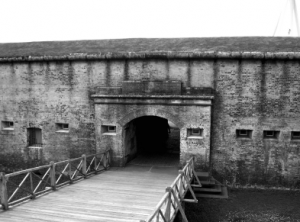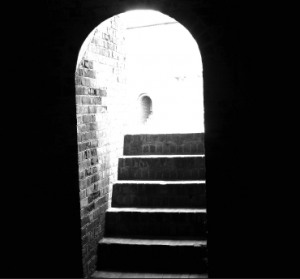The War of 1812 prompted the United States to build a long line of forts along the East Coast for national security. Built by the U.S. Army Corp of Engineers, Fort Macon was designed to protect Beaufort Harbor, a deepwater ocean port. The fort is five-sided, built of brick and stone, and quite striking. Twenty-six vaulted rooms called casements make up the substantial fort, with walls that are almost 5 feet thick.
 The fort became active in 1834; at the beginning of the Civil War, the Confederacy of North Carolina wrestled the port away from Union soldiers. The fort was recovered by Union soldiers in 1862 and served as a federal prison for both civil and military prisoners from 1867 to 1876. Fort Macon was officially closed in 1903. The state of North Carolina purchased the fort from the federal government in 1923 and turned it into a state park. It was reactivated for a brief period during World War II as a coastal defense base.
The fort became active in 1834; at the beginning of the Civil War, the Confederacy of North Carolina wrestled the port away from Union soldiers. The fort was recovered by Union soldiers in 1862 and served as a federal prison for both civil and military prisoners from 1867 to 1876. Fort Macon was officially closed in 1903. The state of North Carolina purchased the fort from the federal government in 1923 and turned it into a state park. It was reactivated for a brief period during World War II as a coastal defense base.
Visually appealing, the fort and surrounding park lie on one of North Carolina’s most beautiful barrier islands. The park is fully restored and open to the public. Besides the fort, there are areas for fishing and swimming, nature trails to hike, a refreshment stand, and beautiful scenery on land and sea to enjoy, which makes the fort and the park one of the most visited parks in the state, reportedly receiving more than 1 million visitors each year.
In 1862, Union forces attacked the fort, and even though the Confederate soldiers were completely surrounded, they refused to surrender. The fort was besieged by heavy gunfire for 11 hours straight, and cannon fire struck the fort more than 500 times. By the next day, the fort was under such strain that the commander, Colonel White, was forced to surrender. While the fort had been able to easily withstand gunfire, cannons quickly penetrated the barriers.
Some reports state that Civil War ghosts haunt the fort, including Confederate soldiers who keep watch for approaching Union soldiers. Others state that the ghosts are former prisoners. Witnesses report seeing soldiers strolling outside the fort and items moving within several rooms inside the fort. There are also sounds of footsteps, gunfire, and men speaking in low voices.
 The fort is beautiful in its own way, and the five-sided shape is intriguing. Exhibits and displays include the fort’s powder magazines, counterfire rooms with cannons, and furnace and bake ovens. Some quarters have been restored to show how soldiers and officers lived there.
The fort is beautiful in its own way, and the five-sided shape is intriguing. Exhibits and displays include the fort’s powder magazines, counterfire rooms with cannons, and furnace and bake ovens. Some quarters have been restored to show how soldiers and officers lived there.
While touring Fort Macon, I didn’t experience any paranormal activity. It was a gorgeous day when we visited the area, and everyone there was enjoying the beautiful weather. Some of the techniques used in ghosthunting include checking for increased solar activity, which has been reported by many paranormal researchers to cause an increase in paranormal activity, as spirits need an energy source in order to appear. When the sun has a solar storm or is releasing solar flares, radioactive particles enter the Earth’s atmosphere, which charges the geomagnetic fields. Ghosts can then access this energy, which allows them to be more active on the earth plane. Moon phases have also been studied, and certain phases, including the full moon cycle, often produce more ghost sightings and paranormal activity.
During my visit, the geomagnetic field was quiet, and solar storms were low. I was also there during a low lunar cycle. I didn’t detect any paranormal activity to note other than the usual energy imprints I pick up any time I’m near a battlefield. This doesn’t mean that the fort is not haunted; it just means that I didn’t encounter any activity during my visit. As with any paranormal investigations, it often takes time and repeated visits to a location under the right conditions to find proof of ghostly activity. Locals and visitors continue to report ghostly experiences while visiting, and I hope to return again to investigate further.
Want more spooky stories of Ghoshunting in North Carolina? Check out Kala Ambrose’s book Ghosthunting North Carolina.